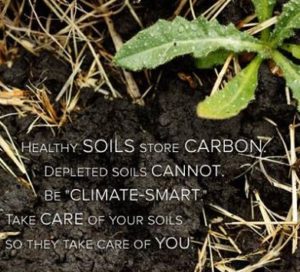
SOIL – The benefits of high organic content in soil: Increased supply of oxygen available to plant rootsEnrichment of the micro-flora and fauna of the soil Increased microorganisms that improve plant nutrition Increased supply of raw material for earthworms Improved retention of water and nutrients Nutrient take-up is associated with the activity of microbes. Even in our own take up of nutrients! Ex. Legumes with Ryzobium bacteria make nitrogen for plants and the microbes in our digestive system help us digest our food too!
The earthworm aerates the soil, improves structure, and helps release nutrients into soil. Earthworm populations are declining and disappearing as more chemical fertilizers are used. Heavy clay soils get very hard and dry and are not a growing ground for tiny tender baby plant! Sandy soils don’t hold water so find out what your plant likes. Plants are as diverse, peculiar, and colorful as people! Some don’t even like being close to each other! A healthy ecological balance in the soil was the food of evolution. Nature not only sustains itself . . .but us as well. If we put poison into it, it feeds us poison!
Soil Structure & Tilth – When the soil is not too wet nor too dry, dig a hole 6 to 10 inches deep. Separate an intact piece of the soil to determine if it is cloddy, powdery, or granular. Break the soil apart with your fingers. The soil should hold its shape under slight pressure. If there are clumps that break apart with difficulty the soil is too hard. Soil rich in organic matter forms relatively round aggregates that create an open, porous soil that allows free movement of water and oxygen so plants develop strong, healthy roots. Compaction Plunge a wire flag vertically into the soil at different locations. Mark the depth at which the wire bends. The sooner it bends, the more compacted the soil. A foot or more of easily penetrable soil is ideal.
Compacted soil inhibits root growth and water availability, and keeps earthworms and other vital soil fauna from circulating freely. Workability If tilling or digging the soil produces cloddy clumps, the workability is low. You can judge by the effort necessary to prepare beds for planting. Soil that’s easy to work is less prone to compaction. Fail this step, and your garden will likely show disappointing results for many of the other tests.
Soil Organisms – Measure animal life in your soil by digging 6 inches and peering into the hole for 4 minutes. If you count less than 10, your soil does not have enough active players in the food chain. A thriving population of fungi, bacteria, insects, and invertebrates is one of the most visible signs of soil quality. There is less opportunity for pests and disease. Soil life does its part to break down plant residue and make nutrients available for plant growth.
Earthworms Dig – 6 inches of soil and count the number of earthworms on the shovel. Three worms are good; five are better. The absence of worms means the soil doesn’t have enough of the organic matter they feed on. Earthworms aerate the soil and their casts infuse the soil with enzymes, bacteria, organic matter, and plant nutrients. They increase water infiltration and secrete compounds that bind soil particles together for better tilth.
Plant Residue – The range of organic material is important to notice here. The presence of recognizable plant parts as well as plant fibers and darkly colored humus indicates an ideal rate of decomposition. The single most important component of healthy soil is organic matter Plant Vigor Look for healthy plant color and size that’s relatively uniform. Overall health and development must be judged for what’s considered normal for your region. Plant vigor indicates soil with good structure and tilth, a well-regulated water supply, and a diverse population of organisms.
Root Development – Dig gently around a selected plant and check the extent of root development, searching for fine strands with a white healthy appearance. Brown, mushy roots indicate drainage problems. Stunted roots might indicate disease or the presence of root-gnawing pests. Without air, water, biological activity, and crumbly soil to grow in, roots can’t do their job.
Water Infiltration – Take an empty coffee can with the bottom removed and push it into the soil until 3 inches remains above the surface. Fill the can with water, marking the water height, and then time how long it takes for the water to be absorbed into the soil Anything slower than 1/2 to 1 inch per hour is an indication of compacted soil. Good infiltration gets water to plants where they need it—at their roots—prevents runoff and erosion, and lets air move more efficiently into soil pores.
Water Availability – The basic lesson is that if plants require more frequent watering than typical for your region, your soil is probably the culprit. Porous soil can better resist evaporation and adequately supply plants between watering. 
Make a soil shake for the classroom.

